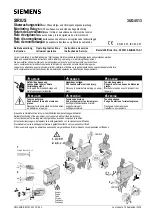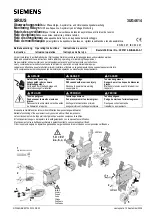
7800 SERIES EC7890A,B/RM7890A,B RELAY MODULE
65-0204–1
8
Fig. 4. Ultraviolet detectors
(Continued).
Fig. 5. Infrared detector.
PRINCIPAL TECHNICAL FEATURES
The 7890 provides all customary flame safeguard functions
while providing significant advancements in the areas of
safety, annunciation and system diagnostics.
Safety Shutdown (Lockout) Occurs If:
1
INITIATE PERIOD
a.
AC line power errors occurred, see Operation.
b.
Configuration jumpers have been changed (after
200 hours).
c.
Four minute INITIATE period has been exceeded.
2
STANDBY PERIOD
a.
Flame signal is present after 40 seconds.
b.
Ignition/intermittent pilot valve terminal is
energized.
c.
Internal system fault occurred.
d.
Main valve terminal is energized.
e.
Three second Flame Failure Response Time
(FFRT) Amplifier is installed and configuration
jumper is selected for relight (see Table 3).
C7076D
3
SAFE START CHECK (EXCEPT 7890C)
a.
Ignition/intermittent pilot valve terminal is
energized.
b.
Internal system fault occurred.
c.
Main valve terminal is energized.
4
PILOT FLAME ESTABLISHING PERIOD (PFEP)
a.
Ignition/intermittent pilot valve terminal is not
energized.
b.
Internal system fault occurred.
c.
Main valve terminal is energized.
d.
No flame present at end of PFEP.
5
RUN PERIOD
a.
Ignition terminal is energized.
b.
Internal system fault occurred.
c.
Main valve terminal is not energized.
d.
No flame present and configuration jumper is
selected for lockout.
e.
Pilot valve terminal is not energized.
SAFETY PROVISIONS
Internal Hardware Status Monitoring
The 7890 analyzes the integrity of the configuration jumpers
and internal hardware. The POWER LED will blink every four
seconds, signifying an internal hardware check.
Closed Loop Logic Test
The test verifies the integrity of all safety critical loads,
terminals 8, 9 and 10. If the loads are not energized properly;
ie, the main valve terminal is powered during STANDBY, the
7890 will lockout on safety shutdown. The 7890 must react to
input changes but avoid the occurrence of
nuisance
shutdown events. Signal conditioning is applied to line
voltage inputs to verify proper operation in the presence of
normal electrical line noise such as transient high voltage
spikes or short periods of line dropout. Signal conditioning is
tolerant of synchronous noise (line noise events that occur at
the same time during each line cycle).
15/16 [24] DIA.
2 (51)
1 (25)
1 INCH NPT
15/16–18 UNC
(2 EACH)
M5084A
2-1/2
(64)
6-7/32
(158)
6-19/32
(168)
2-5/32
(55)
11-13/16 (300)
7-13/16 (198)
1-27/32
(47)
5-13/16 (147)
5-13/16
(147)
C7015
APERTURE
BUSHING WITH
MAGNIFYING LENS
COLLAR, 3/4-14 NPSM
INTERNAL THREADS
3/4-14
NPSM
3/4-14 NPSM
INTERNAL
THREADS
HEAT BLOCK
CELL MOUNT
M1982A
2 LEADS IN A
48 INCH (1.2 METER)
FLEXIBLE CONDUIT
2-3/4
(70)
1-1/4
(32)
1-5/8 (41)
1-1/16 (27)
1-1/4
(32)









































